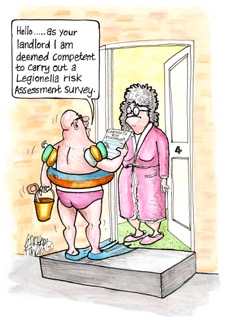What Landlords Must Do to Prevent Legionella
Over a year and a half ago, the Health & Safety Executive (HSE) made its guidelines for prevention of Legionella a legal requirement. But are all landlords aware of their responsibilities?
In April 2014, it became the law for all landlords to conduct regular risk assessments for each of their tenanted properties, whether they manage it themselves or use a letting agent.
Failure to comply with the law is a criminal offence, which could end in a fine or prison sentence.
The Technical Director at Compliance For Landlords Limited, James Homard, explains exactly what Legionella is: “Legionella, or Legionnaires’ disease, is a potentially fatal form of pneumonia caused by inhalation of minute droplets of contaminated water containing Legionella bacteria.”
So how does the bacteria get into the water? “All man-made hot and cold water systems are likely at some point to provide a favourable environment where Legionella can grow,” says Homard. “The organism can colonise large and small water systems so both must be managed effectively to prevent risk of contraction by humans.”
All landlords, including local authorities, housing associations and private rental sector landlords, have a duty of care to their tenants. This includes ensuring the health and safety of the renter.
The HSE L8 Approved Code of Practice (ACoP) was revised in November 2013 to include the control of Legionella bacteria. It applies to premises operated in connection with a trade, business or other undertaking where water is used or stored and there is “a reasonably foreseeable risk of exposure to Legionella bacteria”.
Landlords must organise an assessment by a competent person that is experienced in identifying the risk of Legionella.
Homard says: “It may show that there are no real risks and that water flow is being properly managed with no further action needed, however it is important to review the assessment in case anything changes in the water system. For most domestic hot and cold water systems, temperature is the most reliable way of ensuring the risk of exposure to Legionella bacteria is minimised, by keeping the hot water hot, cold water cold and keeping it moving.”
Landlords could also: flush the system before the property is let; prevent debris entering the system; set temperate controls for the hot water cylinder (calorifier) to make sure water is stored at a suitable temperature; and ensure that any redundant pipe work that could harbour stagnant water is removed.
The risk is also reduced by instantaneous water heaters, such as combi boilers and electric showers, as there is no water storage.
Landlords must be able to provide “documented evidence of a competent risk assessment having been undertaken on your property at least once every two years”.
Homard explains: “The document takes the form of a detailed written report on the conditions at the time of inspection together with a schematic drawing of the water system and any remedial actions that are needed to reduce the risk of Legionella presence.”
So what should you tell your tenant? “Tenants should be advised of any control measures put in place that should be maintained, for example, not to adjust the temperature setting of the calorifier and to clean showerheads regularly,” Homard responds. “They also need to inform the landlord if the hot water is not heating properly or if there are any other problems with the system so that appropriate action can be taken.”
And if your property is not tenanted? “It is important that water is not allowed to stagnate within the water system and, as a general principle, outlets on hot and cold water systems should be flushed for 15 minutes at least once a week to maintain a degree of water flow and minimise the changes of stagnation,” he continues.
But landlords do not need to test or sample water for Legionella; this is only required in “very specific circumstances where a risk assessment has indicated the need”.
Homard confirms: “Testing for Legionella should not be confused with temperature monitoring, which is a reliable method for confirming the water system is safe. Health and safety law does not require landlords to obtain or produce – nor does HSE recognise – a Legionella test certificate.”
And while landlords are not required to record the findings of an assessment, it is advised that they keep a record.
An assessment must be conducted at least once every two years, but Homard also suggests “reviewing the assessment if any relevant changes are made to the property which affect the water system”.
The HSE or local authority inspectors will not inspect properties or request evidence that landlords have undertaken an assessment, however, if a tenant did contract Legionella from the water system at the property, the landlord may be liable to prosecution under the Health & Safety at Work Act (HSWA) and must prove to the court that they have fulfilled their legal responsibility.
Homard suggests: “To ensure you are fully compliant with the law and your tenants are safe, book a professional Legionella Control Association (LCA) registered provider to carry out a water risk assessment.”1
1 Homard, J. (2015) ‘Landlords and Legionella – complying with the law’, Housing Management & Maintenance, November, p.56-57


